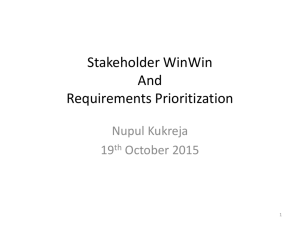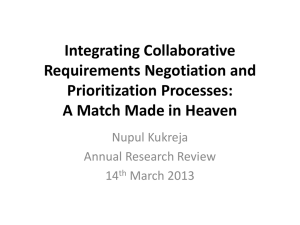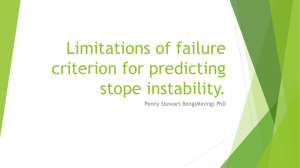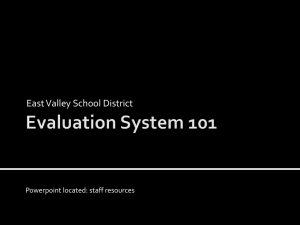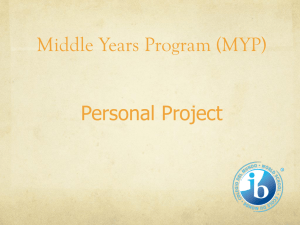EC-16_Value_Based_Requirements_Engineering__Prioritization
advertisement
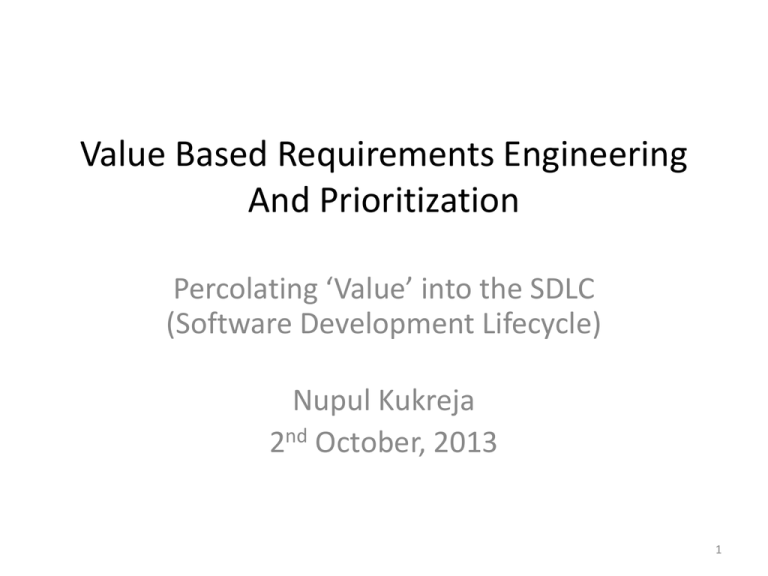
Value Based Requirements Engineering And Prioritization Percolating ‘Value’ into the SDLC (Software Development Lifecycle) Nupul Kukreja 2nd October, 2013 1 Insightful Questions • Given N requirements and budget/schedule constraints which ones to implement? • Which test cases should I run given time constraints? • What programming language should I choose? • Which design should I choose? • What framework should I choose? • What architecture should I choose? • Which project(s) should we choose? • Heck! How do I choose anything? 3 Agenda • The ‘science’ of decision making – what, why and how? • The role of decision making in Value Based Requirements Engineering & Prioritization (VBRE/RP) • Importance of ‘Planning’ • VBRP – what, why & how? • Understanding VBRP in CS577 • VBRP in Action 4 Agenda: VBSE 4+1 View 5a, 7b. Options, solution development & analysis Dependency Theory 2a. Results chains 2. Identify SCS 3b, 5a, 7b. Cost/schedule/ performance tradeoffs 3b, 7a. Solution Analysis 6, 7c. Refine, execute, monitor & control plans Control Theory 6a, 7c. State measurement, prediction correction; Milestone synchronization 3. SCS Value Propositions (Win Conditions) Theory-W: SCS Win-Win 1. Protagonist goals 3a. Solution Exploration 7. Risk, opportunity, change management Utility Theory 4. SCS expectations management 5a, 7b. Prototyping 5. SCS WinWin Negotiation Decision Theory 5a. Investment analysis, Risk analysis 5 Decision Making – What? Definition:* • Decision making can be regarded as the mental processes (cognitive process) resulting in the selection of a course of action among several alternative scenarios • Every decision making process produces a final choice • The output can be an action or an opinion of choice. *Courtesy: http://en.wikipedia.org/wiki/Decision_making 6 Decision Making – Making a Choice Which apartment do you want to live in? 7 Making a Choice – How? • So, just how did you choose your apartment? • What all did you ‘see’ / evaluate before signing the lease? • Examples of possible criteria: – Rent per month – Location i.e., quality of area – Proximity to campus – Presence of a good looking neighbor – …and probably several others 8 Analyzing the ‘Problem’ • You have the two key ingredients necessary for a decision problem: – A list of criteria – A set of alternatives • Problem: Given a list of criteria AND a set of alternatives select the alternative that best suits the given criteria Criteria Decision Apartment Analysis Selection Alternatives Rank ordered set of alternatives apartments 9 Decision Making – Why Bother? • Converts ‘art’ into science – Adds rigor to the act of decision making • Justification of choice of action i.e., why you chose what you chose? – Helps decrease legal liability Ex.: Why did Company A select the bid/tender of Company X over Y? (It’s not only cost ) • Documents the institutional memory that lead to that particular decision (i.e., helps trace back to provide justification of decision) 10 Decision Making – How do you do it? • If it is a well studied science (it is) does anything exist ‘out there’ to help practice this ‘science’? • There are various techniques that can be employed: – – – – Multi-attribute utility theory (ISE 562 in Fall) Analytical Hierarchy Process (AHP) Simple Additive Weighting (SAW) TOPSIS (Technique of Ordered Preference by Similarity to Ideal Solution) – …and many more (http://en.wikipedia.org/wiki/MCDA#MCDM_Methods) 11 Decision Problem – Look and Feel Almost always has a matrix-like representation: Criterion 1 Criterion 2 Criterion 3 … Criterion N Alternative 1 S S S S When considering multiple criteria…in decision Alternative S is often S … making2 theSproblem referred toS as “Multiple Decision Analysis” or Alternative 3 Criteria S S S … (MCDA) S “Multiple Criteria Decision Making” (MCDM) … … … … … … Alternative N 11 12 13 1N 21 22 23 2N 31 32 33 3N SN1 SN2 SN3 … SNN Sij = Measure of how well Alternative ‘i‘ does on Criterion ‘j’ 12 Okay, Great! But what has any of it got to do with VBSE? • Everything!! Control Theory • How do you decide: Which requirement to implement first? Which component to design first? Which architectural style/pattern to use? Which requirements to test first? Which test-cases form part of the regression suite? What all to prototype first? For which component to write the “first line of code”? 13 Wait! But I’ve already done all of this before and I got it right too! • Probably! However… • Were you able to justify your choice i.e., how you came about choosing a specific option? – Was there ever a need to do so? • Just “how” did you decide? – Perhaps intuition, gut feel, domain knowledge, tossing a coin, do as the Romans do… • Yes, a simple 1-10 works or even MoSCoW (Must, Should, Could, Would – have) but for relatively simple problems 14 Short Detour: Planning 15 Purpose of ‘Planning’* • Why do we do it? – Reduce risk & uncertainty – Supporting better decision making – Establishing trust (i.e. frequent delivery) – Conveying expectations • Planning is a ‘quest for value’ – Attempt to find an optimal solution of the overall product development question: What should be built? *Agile Estimation & Planning – Mike Cohn 16 A Good Plan • One that stakeholders find sufficiently reliable • One that can be used as basis for decision making – Approximate time to market – An idea of the set of features • Made more precise as project moves on • Is a ‘living’ artifact showing the current status of the project to avoid last minute surprises • Is planned around ‘value’ 17 Planning for ‘Value’* • Stakeholders needs must be understood • Just delivering features is not important – Necessary to balance scope, schedule, cost and value of features comprising the release • Various factors impacting prioritization – Financial value of having the features – Cost of development – Amount/significance of new knowledge • Product (what) • Project (how) – Reducing Risk (Business/Technical) • Schedule • Cost • Functionality *Agile Estimation & Planning – Mike Cohn 19 Decision Making and Planning for Value • Decision analysis techniques can be ‘overloaded’ to perform requirements prioritization… • …the rank-ordered output of decision making techniques could also rank-order requirements! • Requirements prioritized against the goals/needs/values of the stakeholders VBRP • The prioritized requirements form the basis of the ‘plan’ – what is being delivered, for how much and by when? 20 The ‘Dimensions’ of Value • Value is a multi-dimensional quantity, a simple 1-10 may not cut it (too many ties – Must have, Must-must haves, must-must-must haves etc.) • Value lies in the eyes of the beholder …and so does its dimensions! • Dimensions are ‘hidden’ within the ‘expected benefits’ of the various stakeholders • The benefits serve as the goals/objectives/criteria on which to prioritize the requirements • Point to consider: Are all dimensions* equally important? (*dimensions = benefits = criteria = goals = objectives) 21 Prioritizing Criteria/Value Dimensions • All criteria may NOT be equally important • But just HOW do you prioritize the criteria themselves? – A simple 1-10 (Yes, it works ) – A highly involved process like multi-attribute utility theory (MAUT) to get the utility functions for each criteria which shows the risk attitude of each criterion – Or another interesting technique - Project Success Sliders* * Radical Project Management by Rob Thomsett 22 Project Success Sliders 25% 50% 75% Success Criteria (defined at start of project) Image: Radical Project Management by Rob Thomsett 23 Project Success Sliders 25 1 50 2 100 4 75 3 25 1 75 3 50 2 It’s ‘subjective’ but an extremely effective tool to understand the importance of expectations and their relative tradeoffs! They can (and are) interpreted on a relative scale i.e., twice as important, half as much etc., Image: Radical Project Management by Rob Thomsett 24 Putting It All Together You have: 1.Relative ranking of all criteria 2.List of requirements (or win conditions) What else do you need? • Scores! How well each requirement/wincondition does on each criteria You STILL need something else… • The decision analysis ALGORITHM! 25 Decision Analysis Algorithm: Given a set of criteria with possible weights and the measure of how the alternatives rank on the respective criteria find an optimal alternative Criteria Overall Score Alternatives S(A1) Alternative 1 S(A2) Alternative 2 S(A3) Alternative 3 … … S(AN) Alternative N Criterion 1 Criterion 2 Criterion 3 … Criterion N W1 W2 W3 … WN S11 S12 S13 … S1N The scale of the scores could be S21 S22 S23 … S2N absolute, relative, 1-10 (Likert S31 S32 S33 … S3N Scale), Fibonacci... …must… be consistent across … … … … criterion column SN1 SN2 SN3 … SNN 26 Algorithms for Practicing VBRP • There are various algorithms in literature to choose from along with those from MCDA/M: – – – – – – – – – – Kano Analysis Planning Poker 100-point assignment technique Simple Additive Weighting Quality Function Deployment (House of Quality) Cost of Delay Weigers’ Prioritization Theory-W (Business value vs. Technical Feasibility) TOPSIS …and quite a few more 27 What are we using in CS577? • TOPSIS: Technique of Ordered Preference by Similarity to Ideal Solution (MCDM Technique) • Integrated in Winbook for prioritizing MMFs and win conditions • We’ll be using Business Value, Technical Feasibility and Relative Penalty as the criteria against which to rank the requirements. You may add more (e.g., risk, cost, effort, time – anything you deem appropriate!) • MMFs Prioritized against stakeholders’ value propositions/goals/objectives • Success Sliders for prioritizing value propositions 28 TOPSIS Primer Alternative 1 Ideal Alternative (S’) Criterion 1 Non-Ideal Alternative (S*) Alternative 2 Criterion 2 Aim: Rank order alternatives by their ‘closeness to ideal’ and ‘distance from non-ideal’ Criterion: Has ‘direction of preference’ i.e. more/less of the criterion is preferred Ideal: Best score for each criterion Non-ideal: Worst score for each criterion 29 30 Decision Theory Demo Which tablet should I buy? http://pattaya.usc.edu:8080/Winbook/ projects/2013-USC-Tablets/wall 31 Refinements to TOPSIS/VBRP • Prerequisite Handling (not yet integrated in Winbook) – Specifying MMF/WC prerequisites and factoring in prioritization – Simple solution: Priority of item less than all those in its prerequisite graph • Hierarchical Prioritization (partially integrated) – Prioritizing high level MMFs w.r.t. project goals – Prioritizing WCs w.r.t. MMFs – Prioritizing test cases w.r.t. WCs and so on 32 Points To Note • TOPSIS is ONE way of practicing VBRP • You could even perform COTS tradeoff analyses using it. (It’s a decision problem!) • Use the VBRP technique that is best suited to the situation – each technique has its pros and cons. Choose wisely. • Some prioritization techniques do not lend themselves to a typical spreadsheet like analysis • The output of some techniques could be bucketed (categorized into the MoSCoW buckets) or ordinal (explicitly rank ordered) 33 Conclusion • Tools and techniques for prioritization are only one side of the coin… • …negotiations and discussions are the other. The latter must be held for the former to be of any value. Using the tool will NOT guarantee VBRP • There will be a Homework on VBRP posted tonight/tomorrow, due next week. Watch the class website. 34

